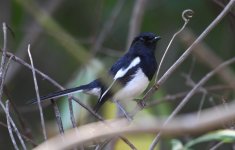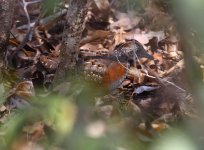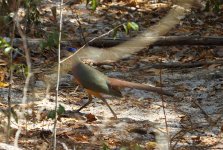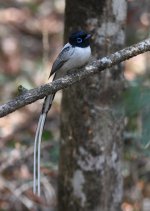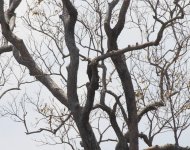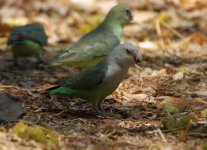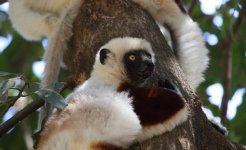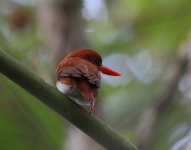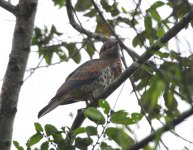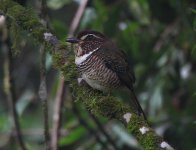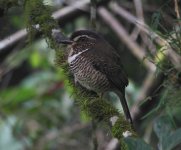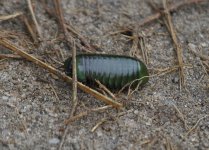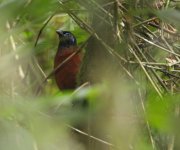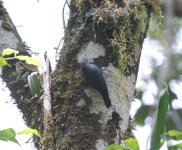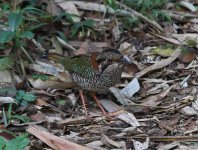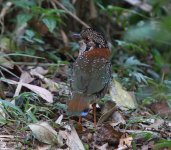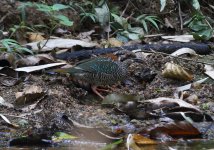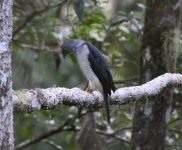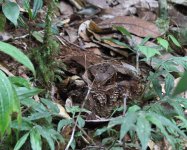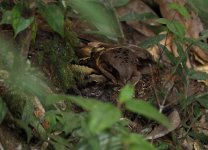edenwatcher
Well-known member
Wednesday 6th October. Part 1.
It wasn’t a very comfortable night with only a floor fan to keep the room cool and a strange and lumpy pillow. After a short drive back along the road past Lac Ravelobe we had a pre-breakfast walk on the trails of the Jardin Botanique B. The trees here were rather taller and lusher than those of Jardin Botanique A. At this early hour the temperature was a very pleasant 20 °C, but it wouldn’t last! Madagascar green pigeons gave us nice perched views feeding on fruit in the canopy, before our attention turned to the forest floor with calling white-breasted mesite. It responded to playback but was only seen as it dashed across a narrow side trail. One of our main targets was the stunning Schlegel’s asity, very much an Ampijoroa speciality. Jacky picked up a male high in the treetops, which was soon joined by a female. Madagascan birds go in for remarkable facial wattles – particularly the couas and asities. Schlegel’s asity has perhaps the most remarkable adornment with a bicoloured wattle of green and cobalt blue – check out Pete Morris’s photos on Surfbirds as mine were poor record shots. A Coquerel’s coua flushed from the path in front and perched up at close range.
I had still not seen hook-billed vanga and, since Ampijoroa is perhaps the easiest place to see the species, we spent a bit of time searching. Finally a pair was located and proved to be yet another vanga that responded well to playback. Jacky detected a bird walking through the undergrowth walking towards a side trail so we waited to see what would appear. We were expecting a coua, possibly red-capped which we still needed, and were rather surprised when a superb white-breasted mesite came into view! Sadly it was gone before we could grab a photo. In the trees by Lac Ravelobe Jacky went off to look (unsuccessfully) for Madagascar pygmy kingfisher whilst we had a go at taping out white-throated rail. It called back vigorously for a while but then lost interest so we headed back to the car. On the way a Henst’s goshawk called and a cuckoo roller could be seen flying over the forest.
Rob
It wasn’t a very comfortable night with only a floor fan to keep the room cool and a strange and lumpy pillow. After a short drive back along the road past Lac Ravelobe we had a pre-breakfast walk on the trails of the Jardin Botanique B. The trees here were rather taller and lusher than those of Jardin Botanique A. At this early hour the temperature was a very pleasant 20 °C, but it wouldn’t last! Madagascar green pigeons gave us nice perched views feeding on fruit in the canopy, before our attention turned to the forest floor with calling white-breasted mesite. It responded to playback but was only seen as it dashed across a narrow side trail. One of our main targets was the stunning Schlegel’s asity, very much an Ampijoroa speciality. Jacky picked up a male high in the treetops, which was soon joined by a female. Madagascan birds go in for remarkable facial wattles – particularly the couas and asities. Schlegel’s asity has perhaps the most remarkable adornment with a bicoloured wattle of green and cobalt blue – check out Pete Morris’s photos on Surfbirds as mine were poor record shots. A Coquerel’s coua flushed from the path in front and perched up at close range.
I had still not seen hook-billed vanga and, since Ampijoroa is perhaps the easiest place to see the species, we spent a bit of time searching. Finally a pair was located and proved to be yet another vanga that responded well to playback. Jacky detected a bird walking through the undergrowth walking towards a side trail so we waited to see what would appear. We were expecting a coua, possibly red-capped which we still needed, and were rather surprised when a superb white-breasted mesite came into view! Sadly it was gone before we could grab a photo. In the trees by Lac Ravelobe Jacky went off to look (unsuccessfully) for Madagascar pygmy kingfisher whilst we had a go at taping out white-throated rail. It called back vigorously for a while but then lost interest so we headed back to the car. On the way a Henst’s goshawk called and a cuckoo roller could be seen flying over the forest.
Rob




